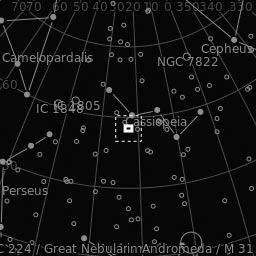
Sh2-188
Planetary nebula in the constellation Cassiopeia.

Planetary nebula in the constellation Cassiopeia.
SH2-188 is a planetary nebula in the constellation Cassiopeia. It was first photographed in 1965 and was initially regarded as the remnant of a supernova, partly due to its asymmetric crescent shape.
| Object: | Sh2-188 |
| Date of exposures: | 27.10.2018, 03.11.2018 |
| Distance: | 711 Lightyears |
| Exposures: | Ha 5nm: 22 x 600", OIII 3nm: 30 x 600", RGB: 50 x 300", Sum: 12,8 Hrs. |
| Telescope: | 10'', F4 Newton |
| Focal length: | 1000 mm |
| Filter: | Astrodon RGB E-Series, H-Alpha 5nm, OIII 5nm |
| Camera: | ASI 1600 MMC Pro |
| Guiding: | Off Axis Guider, Lodestar |
| Mount: | EQ8 |
However, due to the abundance of carbon, nitrogen and oxygen in its outer shell, this object is today now known as a planetary nebula (PNG128.0-4.1).
However, unlike SH2-188, most planetary nebulae have a symmetric shell that expands outward from their dying star. Examples are the Ring Nebula, the Helix Nebula and the Bubble Nebula, to name but a few. The white dwarf as the origin of the PN can be seen weakly in the picture as a small blue dot.
When a dying star between 1-5 solar masses has finally burned all the helium in its core, it becomes a red giant that now burns the helium in its outer layers to carbon. During this phase it drives relatively slow flowing gas into space. Finally the star shrinks, gets hotter and expels the gas faster and faster. This faster moving solar wind catches up and collides with the slower moving gas from the previous phase and forms a bow shock. The bow shock region typically forms a symmetrical shell of pressurized gas excited by the UV emission of the central star. This mechanism of PN formation is known as the "Interacting Stellar Winds" model and explains the shape of most PNs, except SH2-188...
So why is the SH2-188 so asymmetric? One model to explain this is the fast moving PN interacting with the interstellar medium (ISM). As a result of this interaction, the bow shock towards the forward motion remains, but the rear end of the PN essentially travels behind and eventually dissolves. In my SH2-188 image shown above, the forward crescent arc is easy to see, and there is a weaker diffuse portion at the rear end that seems to dissolve.